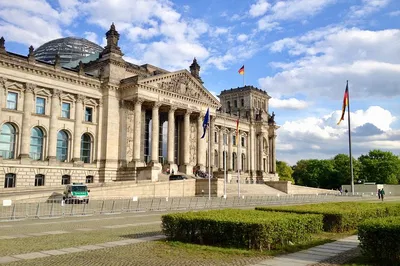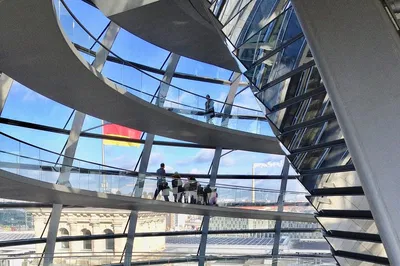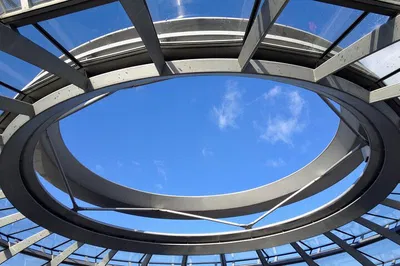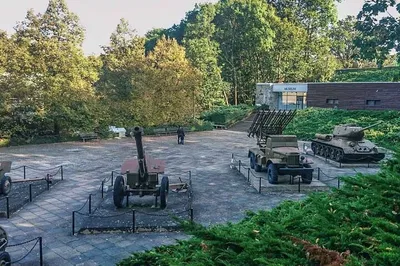City East Berlin: Private History & Architecture Taxi Tour
150
Overview
Private Taxi Tour of City East History and Architecture 2-3h, Berlin. See Berlin's City East in comfort with a local guide. This private taxi tour is perfect for people who want a personal and in-depth look at Berlin's history and architecture. Unlike bus tours, this tour offers the flexibility to customize the route and stops based on individual interests.
During the tour, travelers can expect to see iconic landmarks such as the Brandenburg Gate, a symbol of German reunification, and the Reichstag Building, home to the German Parliament. The tour also includes stops at the Federal Chancellery and the Marie-Elisabeth-Lüders-Haus (Parliament Buildings), offering insights into Germany's political landscape. Travelers will explore Friedrichstrasse Station, Unter den Linden, Pariser Platz, Former Soviet Embassy, Gendarmenmarkt, Bebelplatz (Forum Fridericianum), Neue Wache Memorial, Kronprinzenpalais and Kronprinzessinnenpalais, German Historical Museum, Humboldt Forum (Berlin Palace), Berlin Cathedral (Berliner Dom), Museum Island, Hamburger Straße (Tolerance Street), Hackesche Höfe, Alexanderplatz, Rotes Rathaus (Red City Hall), Nikolaiviertel, Topography of Terror, Potsdamer Platz, Memorial to the Murdered Jews of Europe, Führerbunker Site.
This private tour includes pick up and drop off from your hotel, ensuring a hassle-free experience. It also includes transportation in a comfortable, air-conditioned SUV, Wi-Fi onboard, parking fees and both the taxi ride and the city tour. Entrance fees, gratuities, and snacks are not included. Pick-up from BER airport or outside the S-Bahn ring is available for an extra charge.




Highlights
See Berlin in Comfort: Travel in a private, air-conditioned SUV with Wi-Fi.
Personalized Tour: Customize the tour route based on personal interests.
Local Expert: Learn from a guide who has lived in Berlin for over 20 years.
Hotel Pick-Up: Enjoy being picked up from your hotel in the S-Bahn ring.
Sentiment Analysis
Most customers really enjoyed the personal touch and the guide's knowledge. They liked being able to change the tour to fit their interests. Some people thought the tour could be better if it included entrance fees and pick-up from the airport.

Customers loved having a local guide who knew a lot about Berlin.
Many people liked that the tour was private and they could change it to see what they wanted.
People mentioned the taxi was comfy and made the tour better.
Customers said the guide was friendly and shared interesting stories.
Some customers wished that entrance fees would have been included.
A few people mentioned that pick-up outside of the S-Bahn ring was extra.
The Journey
Brandenburg Gate
The Brandenburg Gate, a symbol of Berlin and German reunification, has witnessed centuries of history. Initially a city gate, it transformed into a symbol of peace until Napoleon seized its Quadriga (four-horse chariot) in 1805. The Quadriga triumphantly returned after Napoleon's defeat, now crowned with an eagle and cross. During Berlin's division, the gate stood isolated, inaccessible from the West. Today, it stands as a powerful emblem of unity and resilience, marking a pivotal point in Berlin's vibrant history.
Reichstag Building
The Reichstag, a Wilhelmine-era architectural marvel, overcame initial criticism to become a symbol of German democracy. The Red Army famously raised its flag atop the building in 1945, signifying victory over Nazi Germany. Overlooking the Berlin Wall, it was largely ignored by West Berlin. Rebuilt in the 1990s for the reunified Bundestag, it boasts a stunning glass dome, a modern addition representing transparency and the 'new Berlin.' Christo's wrapping action dramatically transformed it into an iconographic art piece.
Federal Chancellery
The Federal Chancellery, an eco-colossal structure standing 36 meters tall with ten floors and 500 office rooms, is the hub of German executive power. Designed to dwarf the White House in size, it houses the Chancellor's office and an official apartment (though unused). Its architectural design, reflecting Germany's modern identity, is a symbol of the country's leading role in European politics and its commitment to sustainability.
Marie-Elisabeth-Lüders-Haus (Parliament Buildings)
The Marie-Elisabeth-Lüders-Haus serves as the engine of German parliamentary work, housing committee rooms for discussion and voting. This glass-walled building, stretching over 200 meters, allows transparency into the legislative process. Its rotunda, overlooking the Spree River, hosts meetings of the EU and secret committees. It’s a place of vigorous debate and decision-making, critical to Germany’s political landscape.
Friedrichstrasse Station
During the Berlin Wall era, Friedrichstrasse Station was the sole transit point for journeys from East to West Berlin, including the Paris-Moscow Express. It was also a site for risky escape attempts from East Berlin. Heavily guarded by barriers, customs checkpoints, and Stasi observers, the station was fraught with tension and emotion. Adjacent to the 'Palace of Tears,' where East Berliners bid farewell to visiting relatives, Friedrichstrasse Station is steeped in Cold War history and stories of separation and longing.
Unter den Linden
Unter den Linden, Berlin's grand boulevard, evolved from a tranquil bridle path to a prominent street lined with linden trees. Flanked by significant buildings, including the State Library, Humboldt University, and State Opera, it showcases Berlin's rich cultural and intellectual history. Originally favored by nobility, it now stands as a testament to the city’s evolution, combining historical charm with modern vibrancy.
Pariser Platz
Pariser Platz, once dubbed Berlin's 'good room,' suffered extensive war damage and division. After the fall of the Wall, it was meticulously rebuilt, blending modernized architecture with its historical cubature. Home to landmarks like the Liebermann Haus, the Akademie der Künste, and the French and American embassies, the plaza epitomizes Berlin's post-reunification restoration and its renewed prominence as a global hub.
Former Soviet Embassy
After World War II, the Soviet Union erected its largest foreign representation in Europe here, underscoring its dominance in Berlin. Built in defiance of city statutes, it included an inner courtyard, schools, swimming pools, and ballrooms. The location was chosen to make a statement amid the war-torn American, British, and French embassies on Pariser Platz. Today, it's still used by the successor states of the USSR known as CIS.
Gendarmenmarkt
Often hailed as Berlin's most beautiful square, Gendarmenmarkt is beautifully framed by the German and French Cathedrals and the Konzerthaus Berlin. These "cathedrals" aren't bishop's seats, but rather parish houses embellished by Friedrich II. The German Cathedral now houses a museum of German parliamentary history, while the French Cathedral still hosts services in French. The square's harmonious architecture and rich cultural significance make it a must-see destination.
Bebelplatz (Forum Fridericianum)
Bebelplatz, also known as Forum Fridericianum, is encompassed by significant buildings such as St. Hedwig Cathedral, State Opera, and Humboldt University. A glass window in the floor marks the site of the infamous Nazi book burning on May 10, 1933, offering a poignant reminder of the past. Surrounded by architectural masterpieces, it stands as a cultural and historical nucleus of Berlin, blending intellectual heritage with solemn reflection.
Neue Wache Memorial
Formerly home to the castle guard, the Neue Wache now serves as a memorial for victims of war and terror. Once the site of a changing of the guard ceremony, it now houses an enlarged pieta sculpture by Käthe Kollwitz, a poignant symbol of mourning. This solemn space hosts statesman-like wreath-laying ceremonies, particularly on Memorial Day, reflecting on Germany's past and the human cost of conflict.
Kronprinzenpalais and Kronprinzessinnenpalais
Often overshadowed by the grand structures on Unter den Linden, the Kronprinzenpalais (Crown Prince's Palace) and Kronprinzessinnenpalais (Crown Princesses' Palace) historically served as birthplaces and residences for Prussian royalty. Connected by a corridor, the Kronprinzessinnenpalais now functions as an exhibition space. The Crown Prince's Palace aids in the reconstruction of the City Palace/Humboldt Forum. These palaces offer a glimpse into Berlin's royal past.
German Historical Museum
Housed in the former armory, the German Historical Museum delves into Germany's complex past. Initially a war weapons museum, it transformed into a central museum of German history after the fall of the Berlin Wall. Its renovated exterior frescoes, featuring replica death masks of dying warriors, are a poignant reminder of conflict. The museum provides an immersive exploration of German history.
Humboldt Forum (Berlin Palace)
Rebuilt on the site of the former Berlin Palace, the Humboldt Forum revives the grandeur of Berlin's historical heart. Burned out during the war and later demolished by East Germany, the palace's facade has been meticulously reconstructed, while its interior offers modern exhibition spaces. The Humboldt Forum serves as a bridge between Berlin's past and future, inviting visitors to explore its cultural treasures.
Berlin Cathedral (Berliner Dom)
Berlin Cathedral, despite its relatively young age, stands as a symbol of Berlin's tumultuous history and resilient spirit. Housing the burial place of the Hohenzollern dynasty, its interior reveals a wealth of beauty, from the dome to the crypt. The cathedral embodies Berlin's knack for rebuilding and reinventing itself, blending historical grandeur with contemporary vibrancy.
Museum Island
Museum Island, a UNESCO World Heritage site, is a peninsula in the Spree River housing five world-renowned museums. Established in the 1800s, it began with the Altes Museum for the Berlin Palace's paintings. Expanding to include the Neues Museum with its Egyptian collection (including the bust of Nefertiti), the Alte Nationalgalerie, the Bode Museum, and the Pergamon Museum, it's a treasure trove of art, history, and culture.
Hamburger Straße (Tolerance Street)
Hamburger Straße, also known as Straße der Toleranz, exemplifies Berlin's diverse history. Once the Spandau suburb, it encompasses the Sophienkirche, a Jewish cemetery, and a Catholic hospital, reflecting a blend of religious and cultural influences. Despite past devastation, it serves as a testament to Berlin's enduring spirit of tolerance and coexistence.
Hackesche Höfe
The Hackesche Höfe, a network of interconnected courtyards, offers a glimpse into Berlin's small-scale charm amidst its grand boulevards. Restored after reunification, these courtyards blend residential and commercial spaces, with studios and factories thriving alongside apartments. Offering a unique contrast to Berlin's monumental architecture, the Hackesche Höfe provide a captivating experience of old Berlin's artistic and commercial spirit.
Alexanderplatz
Alexanderplatz, once known as Ochsenplatz, has transformed into a bustling hub in East Berlin. Redesigned during the GDR era as a socialist prospect, it features spacious areas surrounded by modern buildings, including the House of Tourism, the House of Electrical Engineering, and the House of the Teacher. This central square symbolizes Berlin's evolution, from its historic roots to its socialist ambitions.
Rotes Rathaus (Red City Hall)
The Rotes Rathaus, named for its red brick exterior, serves as Berlin's city hall and seat of the governing mayor. During East Berlin times, it housed the East Berlin magistrate, while West Berlin's governor resided in the Schöneberg town hall. Built in the Neo-Gothic style, the building's interior features interesting rooms, including one with plaster casts of famous statues. It stands as a symbol of Berlin's civic administration and governance.
Nikolaiviertel
Nikolaiviertel is a charming reconstruction of old Berlin, built in the 1980s during the GDR era. Featuring the Nikolaikirche (Berlin's oldest church), the Knoblauchhaus (Garlic House), and typical Berlin restaurants with Spree views, it recreates the atmosphere of medieval Berlin. This neighborhood offers a delightful step back in time, showcasing the city's rich architectural and cultural heritage.
Topography of Terror
This site, featuring a surviving section of the Berlin Wall, is a stark reminder of the Nazi regime's horrors. Once the location of the Reich Security Main Office (Gestapo and SS headquarters), the area now exposes remnants of the Nazi regime's infrastructure. Adjacent to the Martin-Gropius-Bau and the Berlin House of Representatives, the Topography of Terror is a site of remembrance and education, confronting the atrocities of the past.
Potsdamer Platz
Once the busiest square in Europe, Potsdamer Platz was reduced to a wasteland during the Cold War. After the fall of the Wall, it underwent a massive transformation, becoming Europe's largest construction site. Today, it boasts modern architecture, including the Mercedes City, the Sony Center with its iconic roof, and the Ritz Carlton Hotel, symbolizing Berlin's resurgence as a global metropolis.
Memorial to the Murdered Jews of Europe
The Memorial to the Murdered Jews of Europe, designed by Peter Eisenmann, is a field of 2,711 stelae that evokes a sense of confusion and insecurity, reflecting the experience of Jewish people during the Holocaust. Located between the Brandenburg Gate and Potsdamer Platz, this thought-provoking memorial serves as a powerful reminder of the atrocities committed and the importance of remembrance.
Führerbunker Site
Although the actual Führerbunker no longer exists, this location marks the site of Hitler's former bunker, where he spent his last days in April 1945. Near the Landwehrkanal, it was here that Hitler and Eva Braun were found dead. Today, only a sign from a local Berlin Underground Club marks the spot, serving as a somber reminder of the final days of the Nazi regime.
Know Before You Go
This private tour includes private transportation in a comfortable, air-conditioned vehicle with Wi-Fi. The price includes both the taxi ride and the city tour, as well as pick up from your hotel, apartment or any other location desired in the city and parking fees. What is not included are entrance fees, gratuities, and snacks. Pick-up from BER airport or outside the S-Bahn ring is available for an extra charge based on Berlin taxi tariff.
Hot Tip
To make the most of the tour, think about what you want to see before the tour starts. That way the guide can show you what you want to see.





